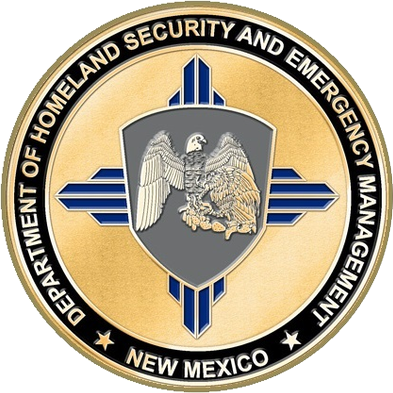Wildfire Preparedness
Wildfire Season is Here – Be Prepared
Overview
To be prepared for a wildfire, it’s important to be ready to evacuate quickly. This means monitoring alerts and warnings information, having a family communication plan, knowing evacuation routes, and having personal items and documents in order. This webpage provides additional information on wildfire basics, how to protect yourself and your property, and what steps to take now.
More and more New Mexicans are making their homes in woodland settings – in or near forests, rural areas, or remote mountain sites. There, homeowners enjoy the beauty of the environment but face the very real danger of wildfire.
Every year across our state, some homes survive – while many others do not – after a major wildfire. Those that survive almost always do so because their owners had prepared for the eventuality of fire, which is an inescapable force of nature in fire-prone wildland areas. Said in another way – if it’s predictable, it’s preventable!
One Less Spark
Public Service Announcements
Public Service Announcements about the importance of preventing wildfires caused from spark-producing activity, such as hot vehicles and power equipment. One less spark means one less fire!
One Less Spark PSA – English One Less Spark PSA – Spanish
Getting Ready
Before a Wildfire
The following are things you can do to protect yourself, your family and your property in the event of a fire.
- To begin preparing, you should build an emergency kit and make a family communications plan.
- Design and landscape your home with wildfire safety in mind. Select materials and plants that can help contain fire rather than fuel it.
- Use fire-resistant or noncombustible materials on the roof and exterior structure of the dwelling, or treat wood or combustible material used in roofs, siding, decking or trim with fire-retardant chemicals evaluated by a nationally recognized laboratory, such as Underwriters Laboratories (UL).
- Plant fire-resistant shrubs and trees. For example, hardwood trees are less flammable than pine, evergreen, eucalyptus or fir trees.
- Regularly clean roof and gutters.
- Inspect chimneys at least twice a year. Clean them at least once a year. Keep the dampers in good working order. Equip chimneys and stovepipes with a spark arrester that meets the requirements of National Fire Protection Association Standard 211. (Contact your local fire department for exact specifications.
- Use 1/8-inch mesh screen beneath porches, decks, floor areas, and the home itself. Also, screen openings to floors, roof and attic.
- Install a dual-sensor smoke alarm on each level of your home, especially near bedrooms; test monthly and change the batteries at least once each year.
- Teach each family member how to use a fire extinguisher (ABC type) and show them where it’s kept.
- Keep handy household items that can be used as fire tools: a rake, axe, handsaw or chain saw, bucket and shovel.
- Keep a ladder that will reach the roof.
- Consider installing protective shutters or heavy fire-resistant drapes.
- Clear items that will burn from around the house, including wood piles, lawn furniture, barbecue grills, tarp coverings, etc. Move them outside of your defensible space.
Plan Your Water Needs
- Identify and maintain an adequate outside water source such as a small pond, cistern, well, swimming pool, or hydrant.
- Have a garden hose that is long enough to reach any area of the home and other structures on the property.
- Install freeze-proof exterior water outlets on at least two sides of the home and near other structures on the property. Install additional outlets at least 50 feet from the home.
- Consider obtaining a portable gasoline powered pump in case electrical power is cut off.
Your best resource for proper planning is www.firewise.org which has outstanding information used daily by residents, property owners, fire departments, community planners, builders, public policy officials, water authorities, architects and others to assure safety from fire – it really works.
Information Resources
The New Mexico Department of Homeland Security and Emergency Management has partnered with State and Federal agencies to provide information on wildfires. Please visit some of the sites below to find useful information:
NM State Forestry Email Alert Signup
Sign up for email alerts on new fires, information on evacuations from New Mexico State Forestry
New Mexico Watch
Near real-time mapping of wildfires and historical data information from the New Mexico Department of Information Technology and UNM-EDAC
New Mexico Fire Info
News feed about new and ongoing wildfires and response activity from New Mexico State Forestry, US Forest Service and Bureau of Land Management

